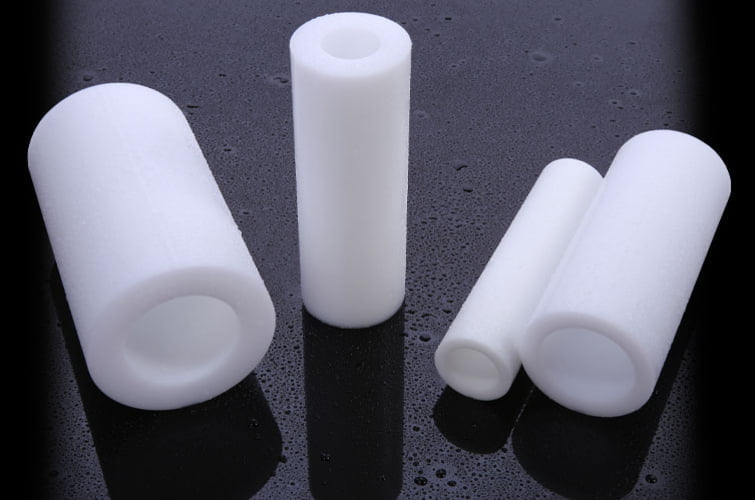
Color – White C-POM material
One of the defining characteristics of C-POM is its ability to maintain dimensional stability under mechanical stress and thermal variations, making it ideal for precision parts in complex assemblies. Additionally, its resilience and low moisture absorption ensure long-term performance without degradation, even in humid or wet conditions.
In terms of friction and wear properties, C-POM exhibits a low coefficient of friction, typically ranging between 0.25 and 0.32 when sliding without lubrication against a stationary surface under specific conditions (16 Mp p=0.05 N/mm², v=0.6 m/s over 5 hours). This makes it particularly useful for applications requiring low friction and smooth operation over time.
The critical pv values (pressure-velocity product) for C-POM vary depending on the speed of application, with figures such as 0.032 N m/mm2 *s at 0.05 m/s, rising slightly to 0.039 N m/mm2 *s at velocities of 0.5 m/s and 5 m/s. These values indicate the material’s capability to handle different levels of mechanical stress and are essential for engineers designing systems that operate under varying dynamic conditions.
C-POM is capable of withstanding a wide temperature range, from -50°C up to +100°C, making it adaptable to environments that experience temperature fluctuations, and can tolerate temperatures as high as +130°C for short periods without losing its mechanical properties.
Additionally, C-POM’s good electrical properties, high chemical resistance, and impressive tensile strength make it a reliable choice for electrical and structural applications. Its very low moisture absorption further enhances its performance in electrical applications where insulation integrity is crucial.
Overall, C-POM’s combination of durability, stability, and low friction makes it a valuable material for creating high-performance parts in automotive, consumer electronics, and industrial machinery, among other fields.
Application C-POM material
POM can be used for production of anti-extrusion rings, guide rings, wipers and for rings that are produced on the machines with tight tolerances. POM is mainly use in cases where high hardness and low friction coefficient are required, for guide and back-up rings, applied at temperature not higher than +100°С. When using POM for a long period of time at high load (back-up rings, tensioning element) the temperature should be not higher than +80°С.
Mainly used C-POM seals
- Guide rings
- Back-up rings
- Special seal parts
- Special wipers
- Valves/valve seat
- Constructional parts
- Bearing shells and sleeves.
C-POM Material Data Sheet
Properties | Value | Unit | Standard |
|---|---|---|---|
Hardness at 20°: | 85 | Shore D | DIN 53505 |
Density: | 1,41 | g/cm³ | DIN 53479 |
Tensile strength: | >70 | N/mm2 | EN ISO 527-2 |
Elongation at break: | >35 | % | EN ISO 527-2 |
Modulus of elasticity: | 3000 | N/mm2 | EN ISO 527-2 |
Charpy impact strength: | > 140 | kJ/m2 | EN ISO 179 |
Compr. strength at 1% deform.: | 100 | N/mm2 | ASTM D695 |
Coefficient of friction (dyn.): | <0.25 | μ | ASTM D1894 |
Water absorbtion to saturation: | < 0.8 | % | EN ISO 62 |
Water absorbtion in 23h: | < 0.2 | % | EN ISO 62 |
Dieelectric strength: | 20 | kV/mm | EN IEC 60243 |
Volume resistivity: | > 1014 | Ω*cm | EN IEC 60093 |
Surface resistivity: | > 1013 | Ω | EN IEC 60093 |
Coefficient of therm. expansion: | 120 | 1/K*106 | |
Min. service temperature: | – 60 | °C | |
Max. service temperature (short term): | + 100 (+140) | °C |
All above established data results from random tests which were taken from the functioning production. All data was stated based on standard test-products in accordance with ISO, DIN and ASTM standards and can substantially not be extended to the completed seal. Our practical technical recommendation, either oral, written or through tests is given in conformity with our best knowledge. However, this data is to be regarded as non-obligatory advice, also taking into consideration any protective rights of a third party, and does not acquit you from making tests with our product in relation to its adaptability for the assigned process and intendment. Utilization, application and processing of the products befall completely outside of our control and are therefore solely your liability. As regards the responsibility, it will be limited to all damages in the value of the product which we delivered and you applied. Certainly, we do assure the immaculate quality of our products in concordance with our general sales and delivery conditions.
Understanding the Differences and Similarities Between POM and C-POM
Introduction
Polyoxymethylene (POM) and C-POM are both highly regarded engineering plastics within the acetal family, celebrated for their exceptional mechanical properties, dimensional stability, and low friction. These materials are pivotal in a variety of engineering applications due to their robustness and performance. This article will delve into the distinct features and commonalities between POM and C-POM, providing insights to determine the most suitable material for specific applications.
Composition and Manufacturing
Both POM and C-POM are derived from the polymerization of formaldehyde, which results in a highly crystalline structure contributing to their durability and strength. The main difference between the two materials lies in their polymerization processes:
– POM: Also known as acetal homopolymer, POM is created through a single-step polymerization process. This method yields a material with high mechanical strength and stiffness, making it ideal for precision-based applications such as gears, bearings, and automotive components.
– C-POM: Known as acetal copolymer, C-POM is produced via a copolymerization process that incorporates a comonomer with the formaldehyde. This adaptation provides C-POM with increased toughness, improved impact resistance, and better chemical resistance compared to its homopolymer counterpart.
Properties and Applications
Despite their different manufacturing processes, POM and C-POM share several beneficial properties like low friction, superior wear resistance, and excellent dimensional stability. However, their distinct characteristics influence their specific applications:
POM: This material is characterized by:
- High mechanical strength and stiffness.
- Good resistance to moisture, solvents, and fuels.
- Excellent fatigue resistance and creep properties.
- Commonly used in high precision engineering, automotive parts, and durable consumer goods.
C-POM: This variant stands out due to:
- Enhanced toughness and impact resistance.
- Increased resistance to chemicals, hydrolysis, and stress cracking.
- Often used in environments exposed to harsh chemicals, such as in chemical processing equipment, pump components, and water management systems.
Conclusion
POM and C-POM are both stellar choices within the realm of engineering plastics, offering robustness and versatility across various applications. The selection between POM and C-POM should be based on specific application requirements, including the need for mechanical strength, chemical resistance, and the operating environment. Collaboration with material experts and performing comprehensive testing are crucial steps to ensure that the chosen material meets the demands of your applications effectively, ensuring optimal performance and durability.
